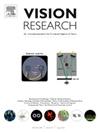识别成人视觉压力最显著的视觉知觉阅读症状是什么?采用探索性因素分析方法编制阿尔斯特视觉压力问卷
IF 1.4
4区 心理学
Q4 NEUROSCIENCES
引用次数: 0
摘要
视觉压力(VS)是一种阅读障碍,其特征是在阅读时出现视觉扭曲症状。VS的诊断是在特殊的基础上,对症状和诊断标准知之甚少。本研究调查了成人的阅读症状,以制定一份临床有用的VS诊断问卷。根据现有文献,编制了一份包含17项内容的综合性阅读症状调查问卷。1248名大学生(18-50岁)完成问卷和模式眩光测试。294名参与者(23.6%)表现出模式眩光(得分>;(3)中空间频率模式眩光测试),该测试被用作皮质过度兴奋的间接测量。在排除确诊的偏头痛患者后,分析了247名参与者的数据。平行分析确定了不同因素的数量,探索性因素分析将症状分配给这些因素。为了确保将症状映射到单一因素,保留的项目需要满足三个条件:(i)对其主要因素的负荷为>;0.40; (ii)对替代因素的交叉负荷为<;0.30; (iii)在项目主要因素和随后的因素负荷上表现出>;0.20的差异。我们确定了五个因素,并将其很好地映射到解释视觉压力的病因学理论中:1)大细胞通路缺陷;2)皮质过度兴奋性;3)眼动/跟踪问题;4)对高时间频率“闪烁”的厌恶;5)与视觉压力相关的并发病理。事后项目分析将问卷内容减少到10个项目。探索性因素分析能够系统地创建一个强大的10项问卷,以帮助视觉压力诊断。问卷将应用于临床背景和不同年龄的验证目的。本文章由计算机程序翻译,如有差异,请以英文原文为准。
What are the most salient visuoperceptual reading symptoms to identify visual stress in adults? Using exploratory factor analysis to develop the Ulster visual stress questionnaire
Visual Stress (VS) is a reading disorder characterised by visuoperceptual distortion symptoms experienced when reading. VS diagnosis is on an ad-hoc basis, with symptomology and diagnostic criteria poorly understood. This study investigated reading symptoms in adults to develop a clinically useful questionnaire for VS diagnosis. A comprehensive 17-item questionnaire was developed probing reading symptoms derived from the existing literature. 1248 undergraduate students (aged 18–50 years) completed the questionnaire and pattern glare test. 294 participants (23.6 %) exhibited pattern glare (scores > 3 on a mid-spatial frequency pattern glare test) which was used as an indirect measure of cortical hyperexcitation. After exclusion of diagnosed migraineurs, data from 247 participants were analysed. Parallel analysis determined the number of distinct factors and exploratory factor analysis assigned symptoms to these factors. To ensure symptoms mapped to a single factor, retained items needed to satisfy three conditions: (i) load onto their primary factor if >0.40, (ii) cross-load onto alternative factors by <0.30 and (iii) exhibit a difference in item primary factor and subsequent factor loadings of >0.20. Five factors were identified and mapped well to aetiological theories proposed to explain visual stress: 1) Magnocellular Pathway Deficits 2) Cortical Hyperexcitability 3) Eye Movement/Tracking Issues 4) Aversion to High Temporal Frequency ‘Flicker’ and 5) Concurrent Pathologies associated with Visual Stress. Post-hoc item analysis reduced questionnaire content to ten items. Exploratory factor analysis enabled systematic creation of a robust 10-item questionnaire to aid visual stress diagnosis. The questionnaire will be applied in a clinical context and among different ages for validation purposes.
求助全文
通过发布文献求助,成功后即可免费获取论文全文。
去求助
来源期刊

Vision Research
医学-神经科学
CiteScore
3.70
自引率
16.70%
发文量
111
审稿时长
66 days
期刊介绍:
Vision Research is a journal devoted to the functional aspects of human, vertebrate and invertebrate vision and publishes experimental and observational studies, reviews, and theoretical and computational analyses. Vision Research also publishes clinical studies relevant to normal visual function and basic research relevant to visual dysfunction or its clinical investigation. Functional aspects of vision is interpreted broadly, ranging from molecular and cellular function to perception and behavior. Detailed descriptions are encouraged but enough introductory background should be included for non-specialists. Theoretical and computational papers should give a sense of order to the facts or point to new verifiable observations. Papers dealing with questions in the history of vision science should stress the development of ideas in the field.
 求助内容:
求助内容: 应助结果提醒方式:
应助结果提醒方式:


